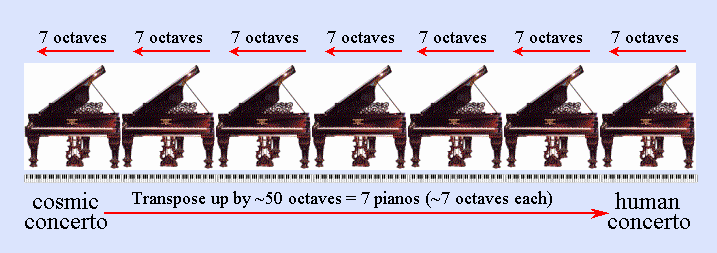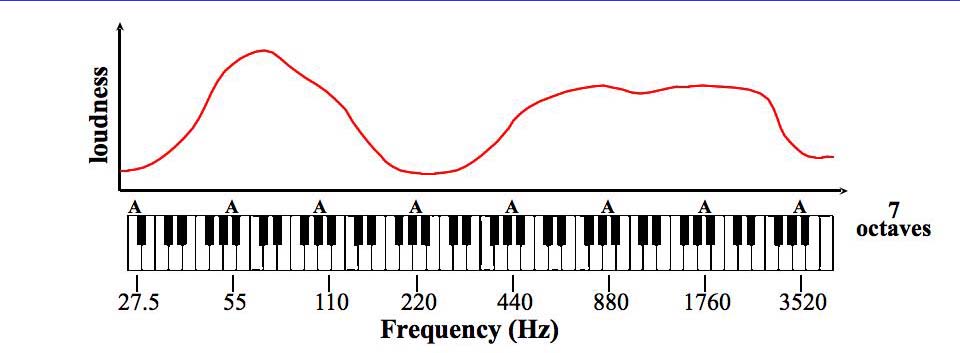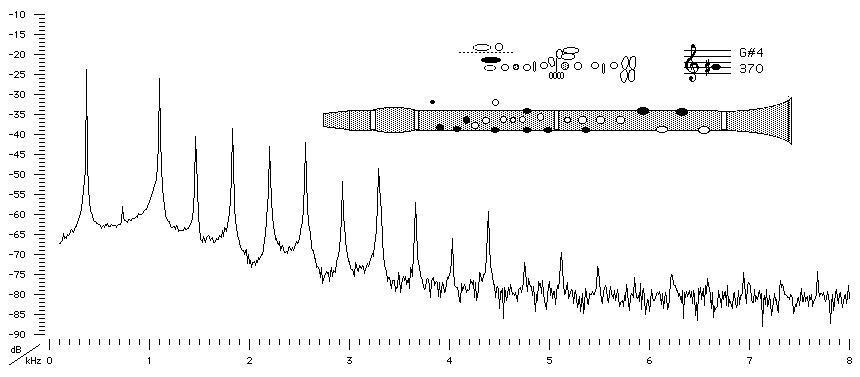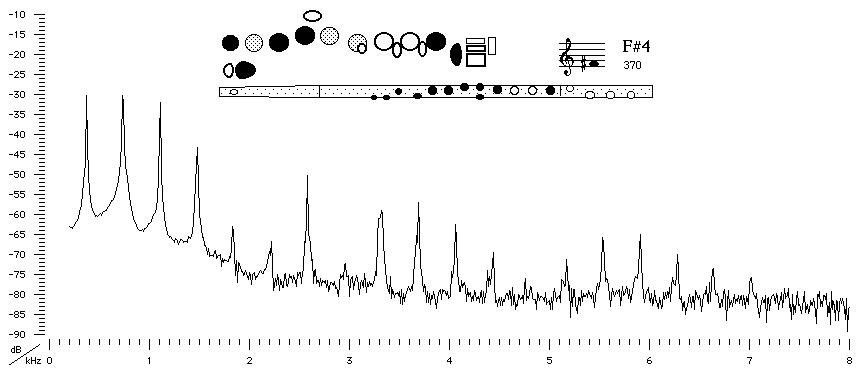

The variations in brightness are caused by slight differences in density, temperature, and pressure from place to place. This leads to two distinct, but equivalent, ways to think about the variations:
One perspective considers the patchiness as peaks & troughs of density:
Gravity will slowly amplify these density variations, so that in time...
Another way considers the patchiness as peaks & troughs of pressure:
These are sound waves moving back and forth in the hot gas.
The images below illustrate the situation. Imagine looking down on the ocean from a plane and seeing far below, surface waves. The patches on the microwave background are peaks and troughs of distant sound waves.

|
Water Waves: high-low water surface height (ignore central flower) |
| Both contain many waves of different sizes, directions and phases, all superposed. | |

|
Sound Waves: red-blue gives high-low gas and light pressure. |
As school children we learn that the roar of interstellar space-craft or the zing of photon torpedoes are fictions of the movies – we know that outside our atmosphere the vacuum of space must be utterly silent. So how can sound be present in the Universe? Surely this contradicts one of our earliest learned "facts" of science? The answer is that space was not always so empty...
The previous sections remind us that at the time of Cosmic Sound the Universe was much smaller (by at least a factor of 1000), and all the matter we now find in stars and galaxies was spread out uniformly. Add to this the fact that the young Universe was also much hotter, and we learn that over the first million years, all of space was filled with a hot thin uniform glowing gas, a billion times denser than the current cosmic density. Not only did the Universe have an atmosphere – in a sense, it was an atmosphere. It was within this atmosphere that sound waves could form and move in the young Universe.
If the patches on the CMB are pressure waves, what do they sound like?
To answer that, we need to consider three important aspects of sound: Loudness; Pitch; and Quality. Let's take these in turn.
The loudness of sound depends on the strength of the pressure waves — how much the pressure varies from peak-to-trough, compared to the mean pressure. In the diagram below, that's ΔP/P. Our ears are, in fact, exceedingly sensitive to very slight variations. Our decibel scale of loudness starts at a billionth for the quietest sounds (0 dB), and goes up to a thousandth for deafening sound (135 dB).
How do we measure the pressure variations in the primordial atmosphere? Simple: we look at the brightness variations on the CMB. These variations tell us the strength of the pressure waves were between one ten-thousandth (10-4) and one hundred thousandth (10-5). So these correspond to around 110 decibels. This is neither inaudibly quiet nor lethally loud: it is powerfully loud — it is about as loud as a rock concert!.

|
The pitch we hear depends on the number of waves passing our ear each second. Technically, this number is called the sound's frequency and is measured in Hertz (Hz). For example, for humans, very deep to very high pitch spans 20 to 20,000 waves per second, or 20 Hz to 20 kHz. The figure below shows how frequency is mapped onto our musical notation, and also a piano keyboard match frequency.

|
1000 Hz |
What were the frequencies of the primordial sound waves? Very low! Roughly one wave every 20,000 to 200,000 years! Expressed in Hertz, that's about 10-12 to 10-13 Hz. This is about 48 to 52 octaves below concert A (which is 440Hz). So the cosmic sounds are exceedingly deep — way too deep for humans to hear.
One way to illustrate this is to imagine a sequence of ever-deeper pianos — the top note of the next piano continues from the bottom note of the previous piano. With 7 octaves for each piano, we must go 7 pianos down the sequence before we can play the cosmic concerto at its authentic pitch. Following normal musical tradition, one can transpose music up or down in pitch to suite the available instruments. In our case, we must transpose up by 50 octaves to play creation's chords on a normal, human, piano.

|
There is a simple reason the primordial sound is so deep — the Universe is very big! The diagram below reminds us that the air within bigger pipes vibrates more slowly giving a deeper pitch. In the young universe, the size of the regions vibrating are many thousands of light years across so their vibrations are exceedingly slow, and hence the primordial sound is exceedingly deep.

|
What was the sound like: a note, a chord, a roar, a crackle, or what? This aspect of a sound is called the sound's "quality". The sound quality depends on the relative amount of each pitch, and a graph of this is called the sound spectrum (cosmologists prefer a slightly different term: "power spectrum"). Here's a sketch of a sound spectrum, using a piano keyboard for the pitch axis. It has some base and treble but not much mid-range. Because the spectrum is broad and smooth the sound is roaring/hissing rather than note-like.

|
Sound |
Below are two real sound spectra from musical instruments: a clarinet & flute. Each is playing a note with fundamental frequency 370 Hertz:

|
Clarinet |

|
Flute |
Musical instruments have sound spectra with many spikes, called harmonics, with the lowest one called the fundamental. While the fundamental usually gives the note its overall "pitch", it is the sequence and strength of the harmonics that give the instrument its particular "quality" or "tone".
Harmonics arise from specific modes of vibration across finite sized objects. For columns of air and stretched strings the harmonics are evenly spaced in frequency. More general objects (wine glasses, drums, bells) have more complex ways of vibrating and have unevenly spaced harmonics.
What was the sound spectrum of the primordial sound? Find out in the next section (5), after the review.
Since much of what is to come involves sound and sound spectra, it is important that you feel comfortable with them at this time. So let's review them briefly:
Sound is a pressure wave moving through a fluid - regions of higher and lower density and temperature adjacent to each other. Like surging crowds at a football match, these regions of extra pressure move: denser regions push their way into sparser regions, which then become denser, and the motion continues.
During the foggy period, the fluid is an intimate mix of light and gas. Because of light's importance the sound waves move quickly – about 50-60% of light's speed.
The amount of pressure variation was only slight, about 1/10,000 of the average pressure, and this corresponds to a rock concert volume of about 110 decibels (dB).
The number of waves passing your ear per second – the sound frequency in Hertz (Hz) – gives the sound its pitch. Since these waves would pass you once in 40,000 years or more, they are very deep — about 50 octaves below our audible range.
The property that gives a sound its quality is the mix of pitches present. Hissy sounds have many high pitches; rumbling sounds have many low pitches. A graph of the amount of each pitch is called a sound spectrum (the term "power spectrum" is also used); it defines the sound quality.
Many vibrating objects, including musical instruments, have sounds with a single dominant lowest frequency (a fundamental), with a number of higher frequencies (harmonics) at multiples of the fundamental. For musical instruments, then, the relative strength of all the harmonics gives an instrument its particular sound. In our example, the clarinet has more mid-range harmonics than the flute (even playing the same note) and so its sound is a bit less rounded – a bit more reedy.
Human hearing ranges from about 30 Hz to 15 kHz in pitch, and from 0 to 130 dB in volume. Hence normal sound spectra usually plot these two ranges.
It is interesting to compare sound spectra and light spectra — both usually have a broad spread of frequencies as well as sharp spikes. In each case, the spread comes from unconstrained vibrations, while spikes come from resonant, or constrained, vibrations. For light, the resonances are electron waves traversing atoms, while for sound the resonances are flexing or pressure waves traversing an object.